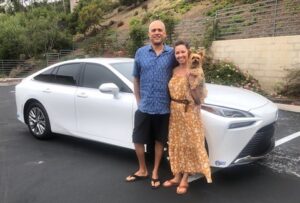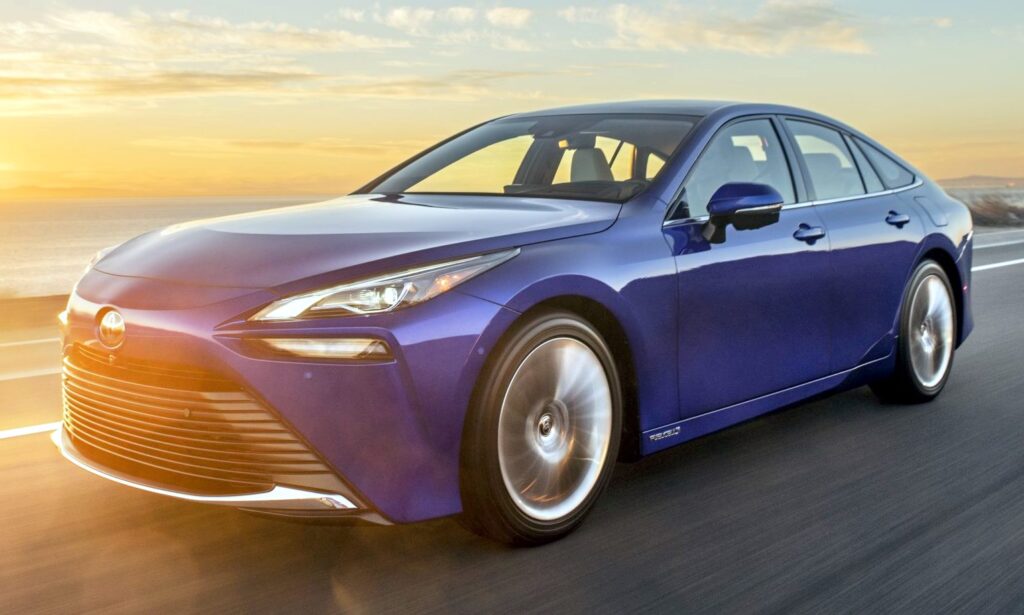Behind the Scenes with a Couple & Their First Fuel Cell
Everything is a first time. You name it, because at some point you have never done it until you did it. This is what makes life so exciting and interesting; trying new things and going new places. But what if your first time doing something is so completely different and out of character personally, it could redefine who you are and even change your thinking? Welcome to the world of owning an electrified vehicle.

A First Timer for us is someone who purchased their first EV, PHEV or FCEV. This possibly confusing jumble of letters simply means their car has a plug, such as an electric vehicle (EV) or a plug-in hybrid electric vehicle (PHEV), or produces its own electricity using a hydrogen fuel cell (FCEV).
Clean Fleet Report will occasionally speak with a First Timer to hear what their experience was like. It’s a look beyond what the car is like in the abstract to what it means in a person’s life, particularly if this car is the kind of new technology that prompts a lifestyle change.
In this case we met with a married couple, Ken and Molly (and their dog Sushi) who purchased a 2021 Toyota Mirai FCEV. Their purchase process is very modern, especially for a vehicle with a radically different propulsion system from the gasoline-powered cars they own. Enjoy!
Clean Fleet Report: Tell us a bit about yourselves.
Ken: We live in South Orange County, California. My commute of three to four days a week is about 60 miles round trip, and Molly’s is 120 miles round trip, once or twice a week. So Molly is the primary driver of the Mirai.
CFR: Tell us about the research and shopping experience and the purchase decision process, such as did you buy or lease the Mirai, when did you begin researching new cars, and what dealer did you go with.
Ken: We first talked about getting a new car in early March 2021, and after some research online, we bought (not leased) the Mirai later that month. I am not an impulse buyer of anything, but after two days of looking at the reviews and the incentives, it made sense. We contacted two Toyota dealers and only one, Tustin Toyota, got back with us. We wanted the base Mirai XLE in white, and with no options. The first time we saw the car up-close and sat in it was when we went into the dealership to sign the papers, so the complete process was online and through email.

CFR: What drew you to the Mirai?
Ken: The incentives were too good to turn down: 72 months at zero percent interest, and a $15,000 hydrogen-fuel debit card. Considering Molly was spending $300 per month on fuel, the Mirai is essentially a free car. The carpool lane sticker is a nice benefit. We plan on paying-off and keeping the Mirai even once the fuel card is depleted, which at our pace should be in three to three and a half years.
CFR: Let’s talk about your experience driving the Mirai. Since this was your first electrically powered car, and you had never previously driven any electric car, what are your impressions?
Molly: Our previous cars were pretty basic, and at first, the technology aspect of the Mirai was a little distracting, but now I am comfortable with it, and I could never go back. The car is super comfortable and I love all the adjustments you can make with the seats. Visually there are no blind spots, and it feels safe. I have absolutely no complaints with anything inside the cabin, and the design is great. The Mirai is very quiet on the road, and driving over bumps is so smooth.
Toyota says the Mirai can go 400 miles, but we are getting around 300. I almost always drive on the freeway, at speeds up to 70 mph, or am stuck in slower traffic.
Editor’s Note: Molly is not a Hyper Miler, which are people clogging the car pool lane going at or below the posted speed limit with the goal of obtaining the longest range possible. This contest can cause traffic issues, but it also results in electric cars surpassing the manufacturer’s driving range estimate. Clean Fleet Report urges everyone to drive safely based on the road and traffic conditions.
CFR: What have your experiences been with fueling?

Molly: I watched a video on how to fuel, and we downloaded the app showing the hydrogen fueling stations. I look at it all the time to see the current status of the pumps, but of course the one time I didn’t look at the app I get to the fueling station and the pump has a lock on it. This is the frustrating part, that when one (pump) is down there can be four or five people lined up. It would be nice if the stations would have three or four pumps. Another issue is the freezing-up of the handle and the hose after they have been used constantly.
Editor’s Note: Hydrogen is cooled to -40°C so it can be quickly dispensed. Cold hydrogen turns moisture in the air into frost on the nozzle and receptacle. Sometimes the frost becomes ice—particularity after back-to-back fuelings—and the cold metal of the nozzle latching mechanism freezes. If this happens, shake the nozzle to dislodge any water or ice, or wait a few minutes for the ice to melt. Otherwise, it is a simple process once you learn how to attach and disconnect the nozzle. A complete fill-up takes only a few minutes, about the same time as filling a car with gasoline.
CFR: How low have you taken the range?
Molly: Thirty miles is my comfortable minimum, but recently it got as low as 15 miles.
Ken: The lowest I ever took it was to three miles.
Molly: (laughing) I was afraid to drive it and made Ken go fill it. Growing-up, our family car was a VW bus, which had a broken gas gauge. My mom was always doing the math, but I don’t even want to tell you how many times we ran out of gas and (ended up with) me having to push the VW bus. I am always saying–“let’s fill it”–and Ken is saying–“I got it, we can wait.” I think I have PTSD, so I like having the Mirai filled.
CFR: Do you have any closing thoughts on owning a Mirai?
Molly: I think it is changing the mindset. I was reluctant to fill it, but once you get used to it, that is the only difference between a gasoline- and hydrogen-powered car. When I speak with co-workers that drive even further than I do, and they are looking into alternatives, I am touting the Mirai because I love it. Ken has told his sister and our friends too.
Ken: Molly was not a big fan initially, but now I can’t get her out of it. It was going to be my car, but I was more concerned with her being safe on her commute to work. It is great she loves it so much.
Story and photos by John Faulkner
Make sure to opt-in to the Clean Fleet Report newsletter (top right of page) to be notified of all new stories and vehicle reviews.
Check out our reviews of the Mirai—both the second generation like Ken and Molly’s and the first generation version that came out in 2015 in the U.S. We liked it, too.
Flash Drive: 2021 Toyota Mirai Fuel Cell Electric Vehicle
Take Two: 2021 Toyota Mirai Fuel Cell Electric Vehicle
Road Test: 2018 Toyota Mirai Fuel Cell Electric Vehicle

1 thought on “FIRST TIMER – 2021 Toyota Mirai”